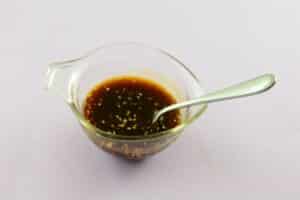For a quick, easy, and well-balanced meal, you can never go wrong with a stir fry dish. Sear a protein, saute a few vegetables, cook up some rice, and finish it off with a delicious sauce.
The sauce is arguably the most important ingredient of the stir fry. The sauce gives it flavor and takes the dish from a bowl of chicken and broccoli to a savory dinner.
How We Evaluated Stir Fry Sauces
We evaluated the stir fry sauces based on the following criteria to find the best stir fry sauce to buy:
Taste
We looked for sauces that have that distinctive rich umami flavor that our senses expect from a stir fry dish. We wanted a sauce that has a well-balanced taste that was not too sweet and not too spicy and would satisfy the majority of people’s tastes.
Most importantly, the sauce should not have an artificial, commercial after-taste that is sometimes present in store-bought sauces.
Quality of Ingredients
Some home cooks are hesitant to use store-bought sauces out of fear that they will be full of artificial additives and subpar ingredients.
We evaluated the vast selection of stir fry sauces for the best-bought stir fry sauce and looked for those that contained as many pure and natural ingredients as possible, both to give you the best taste and quality.
Nutrition
Store-bought sauces are known to contain a high amount of sodium and sugar. While taste still trumped nutrition in our reviews, we did try to take the salt and sugar levels into account when selecting the best stir fry sauces to buy. We were also pleased to discover that most of our top picks did not contain high fructose corn syrup, an ingredient that has a controversial reputation.
Texture and Consistency
The thickness and texture of the sauce can affect your dish. You don’t want a sauce that is too thick, making it more of a spread than a sauce. A thick sauce can clump and give the food an unappetizing presentation.
On the other hand, you don’t want a sauce so thin that it is runny and won’t stick to the food. The ideal consistency in a sauce will glaze the food in a thin, shiny, and appealing coating.
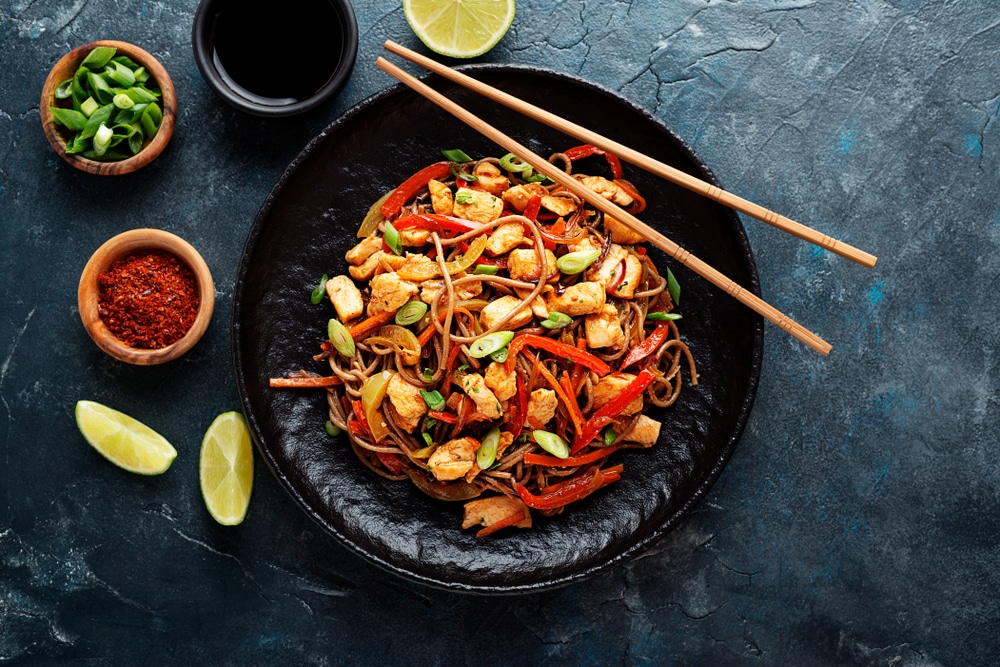
Best Store Bought Stir Fry Sauce Brands
Here are our top recommendations for best stir fry sauce:
1. Kikkoman Takumi Stir Fry Sauce
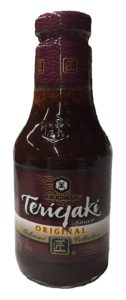
We love the taste and the texture of the Takumi Teriyaki Sauce from Kikkoman, one of the best stir fry sauce brands. The sauce has a deep flavor and speaks of authenticity. The sauce is on the thicker end of the consistency scale so it will coat your food well.
It is also perfect for marinating meat, chicken, or fish, in addition to being fantastic for a stir fry sauce. We also like it as a dipping sauce. The sesame seeds bring it up a notch both in presentation and in taste.
The teriyaki sauce is made from soy sauce, mirin (sweet rice wine), garlic, ginger, onion, and sesame seeds.
- It has a rich Japanese flavor.
- It complements all proteins.
- The thicker texture makes it excellent for basting, marinating, and stir-fries.
- It does not contain high-fructose corn syrup.
- It is high in salt, so go easy on the sauce if you’re watching your sodium intake.
2. Lee Kum Kee Panda Stir Fry Sauce
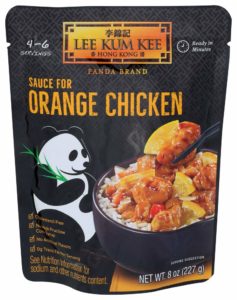
Chicken stir fry and the Lee Kum Kee orange sauce are a match made in foodie heaven. The sauce will give your dish a genuine Asian-restaurant taste with minimal effort. We found this orange sauce to be the best stir fry sauce to buy for chicken. We also like that it comes packaged in six separate packets for easy storage and usage.
The texture is on point: thick enough to coat the chicken but thin enough to pour the sauce out easily. Coat your cubed chicken in cornstarch before frying it to take it to the next level.
The main ingredients in this condiment are sugar, soy sauce, orange juice concentrate, milk, and spices.
- It has a sweet and tangy restaurant-grade taste.
- It does not contain high fructose corn syrup and has no artificial flavors.
- The package has clear directions for how to best cook with it.
- It contains a lot of sugar and is higher in calories than some other sauces.
- It may be too spicy for your tastes.
3. Mr Spice Ginger Stir Fry
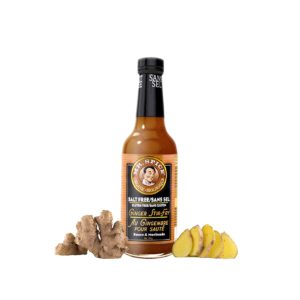
Store-bought sauces are known to be full of salt, sugar, artificial flavorings, and additives, so it was a pleasant surprise when we came across this flavorful sauce from Mr. Spice. Since many soy sauces contain wheat, it was exciting to find this gluten-free option.
We may have just discovered Mr. Spice’s sauces, but we’re not the only ones. They have won first place in the American Royal International Sauce Contest. However, if you’re used to heavily salted foods, you may find Mr. Spice’s sauce to be a bit lacking in taste. For someone accustomed to a low-sodium diet, the sauce should hit just the spot.
This stir fry sauce does not contain soy sauce as most others do. Its main ingredients are evaporated cane juice, rice vinegar, ginger, blackstrap molasses, and spices.
- The sauce is organic.
- It is gluten-free, making it an excellent choice for those on gluten-free diets.
- It is salt-free, a rarity for stir-fry sauces.
- The sauce is lower in calories than most other sauces.
- The taste may not be on par with other sauces due to being salt and fat-free
4. 365 by Whole Foods Market Organic Sauce

We love the Asian umami flavor and the viscosity of this stir fry sauce. It gives the food a picture-perfect glaze for a magazine-worthy dish. Use it on plain rice as well to give it a boost of flavor. It’s delicious over wings too, if you’re looking for other ways to use the sauce after your stir fry.
Another positive characteristic of this sauce is that it is organic! If you’re looking for a more wholesome, organic stir-fry sauce, this one is a delicious option.
The ingredients in this organic sauce include soy sauce, sugar, vinegar, ginger, garlic, molasses, sesame oil, and xanthan gum.
- It has a superb consistency and texture.
- The sauce is organic.
- It’s not as sweet as other teriyaki sauces.
- The ginger might be too strong for some tastes.
5. Minor’s Stir Fry Sauce
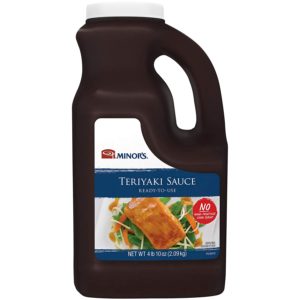
The sweet sauce is made from soy sauce, brown sugar, molasses, sherry, sesame oil, and spices. It is perfect for a stir fry sauce, marinade, or dipping sauce. You’ll find yourself reaching this versatile sauce all the time, and the bulk bottle won’t last as long as you would expect.
The oversized bottle is designed well, so it is surprisingly easy to carry and pour. Its shelf life is up to a year, so there’s no pressure to use it up immediately.
The consistency is a little thinner, but it will thicken up when you cook it with the food.
- It does not contain high-fructose corn syrup.
- It pours out easily from the large jug.
- The sauce has a well-balanced taste.
- It is higher in calories and sugar than other sauces.
What is a Stir Fry?
A stir fry dish is usually composed of pieces of protein, such as poultry, meat, tofu, or fish, and a variety of vegetables, cooked in the stir fry technique. It is typically served over a bed of rice or noodles.
A stir fry refers to the technique of cooking food quickly in a wok or pan in hot oil and stirring the food so it doesn’t burn. Cooking the food quickly helps the vegetables keep their color, taste, and texture. This cooking method is believed to have started in China and then spread throughout Asia and then to the West.
A stir fry dish typically consists of three components: proteins, vegetables, and sauce. It’s a very versatile, mix-and-match meal that can suit any occasion, budget, dietary needs, and tastes. It’s a great way to repurpose leftover chicken or vegetables from a previous meal or to stretch a protein to feed more mouths.
If you don’t have enough chicken to serve each person a piece, simply chop it up and turn it into a stir fry dish! The vegetables and rice or noodles you serve it with will bulk it up and turn it into a satisfying meal.
Stir-Fries are easy to make and quick to assemble and cook. Prepare all the ingredients before you begin as they cook quickly. Try to cut your ingredients into similar-sized pieces to ensure they cook uniformly. You don’t want to end up with one raw cube of chicken and another one that is burnt.
- Select one pound of protein and cut it into bite-size pieces. Some protein options that work well in a stir fry are chicken, turkey, beef, pork, shrimp, tempeh, and tofu.
If you’re using meat, choose a thin cut that cooks quickly. When you cut the meat into cubes, cut it against the grain for the best texture. If you cut the meat along the grain, it will come out tough and chewy. It’s optimal to tenderize the meat ahead of time to get the best and softest texture.
If you’re using tofu, drain it and dry it first. It won’t brown well if it’s wet and you don’t want soggy tofu crumbles in your dish.
- Select two pounds of a variety of vegetables and cut them into bite-sized pieces. Some vegetable options include onions, bell peppers, snow peas, broccoli, cauliflower, carrots, celery, zucchini, asparagus, mushrooms, baby corn, and your favorite vegetable. Be creative! The options are limitless.
- A teaspoon of aromatics such as ginger, shallots, and garlic is optional but will give your dish a boost of flavor.
- Use your heaviest wok or frying pan. Preheat your wok or pan on low heat until it is hot. Pour in 1 – 2 Tablespoons of oil, enough to coat the bottom of the pan. If your pan is non-stick, you can use a little less oil.
- Add your choice protein to the hot pan and cook it on all sides until they are brown. Don’t continuously stir them as they cook or they won’t brown. It’s best to let them cook for a minute, then stir, and cook for another minute.
- Remove the protein from the pan and set the pieces aside.
- Add the chopped vegetables and saute them for one to two minutes, occasionally stirring them. If you have too many to fit into the pan at once, cook them in batches. You don’t want to overcrowd the pan.
Some vegetables cook quicker than others. Add the harder vegetables that take longer to cook first to the pan. Cook them for a minute first and then add the softer vegetables. For example, carrots will take longer to cook than peppers or mushrooms. If you’re using a mix of frozen and fresh vegetables, add the frozen vegetables first as they will take longer to cook.
- Add the aromatics and cook for another 30 seconds. Stir them constantly as the small pieces will burn if they’re on the fire for too long.
- Add the protein back to the pan.
- Now you’re finally ready for the stir fry sauce! Pour about ⅓ cup of your choice of stir fry sauce over the protein and vegetables in the pan and stir so that all of the food is coated. If you’re using a thin sauce, you can add some cornstarch to thicken it up. The longer you cook the sauce, the thicker it will get as the liquid evaporates.
- Serve the stir fry over rice or noodles, and top it with an optional garnish. The garnish can be chopped herbs, scallions, or nuts. Toasted peanuts or cashews go well with a stir fry.
- Feel free to add more of the stir fry sauce to your rice or noodles. If you have extra grains leftover, the sauce will taste great on it without the stir-fried vegetables and protein too!
What is a Stir Fry Sauce?
You may have noticed that some of our top stir fry sauces are labeled by the manufacturers as other sauce descriptions such as teriyaki and orange sauce. What makes a sauce a stir fry sauce?
Just as the proteins and vegetables in a stir fry dish are versatile and flexible, the sauce can also vary in flavors. There isn’t a specific component that identifies it as a stir fry sauce. However, a stir fry sauce is typically made from soy sauce which gives it the Asian-cuisine taste.
Other ingredients are added to the soy sauce to give it either a deeper depth of flavor, add sweetness, or thicken the sauce. The following ingredients may be included in the sauce:
- Cornstarch – to thicken the sauce
- Water – to dilute it out
- Chili powder – for heat
- Honey or sugar – for sweetness
- Rice vinegar – for flavor
- Pineapple – for optional flavor
- Garlic – for flavor
- Ginger – for flavor
Other Sauces that Can be Used for Stir Fry
Sauces labeled for dishes other than stir fry can make an excellent condiment for your stir fry too.
- Teriyaki sauce is usually a sweeter sauce that is meant for you to brush on chicken, meat, fish, or vegetables before you grill them, but you can use it for stir fry too. It has origins in Japanese cooking. Teriyaki sauce is made from soy sauce and mirin and has a sweet and salty flavor. We covered teriyaki sauce extensively in our best teriyaki sauce article.
- Hoisin sauce is a thick, spicy sauce that is used mostly in Cantonese-style cooking and in stir fry foods. It’s made from fermented soybean paste and usually has garlic, vinegar, sugar, chiles, and sesame as ingredients too.
- General Tso sauce is a versatile sauce that goes well with almost any protein and vegetable combination, but we particularly recommend it if you’re making a tofu stir fry. It is a pungent sauce that is heavy on garlic and chili. It’s made from soy sauce, rice vinegar, sugar, ginger, red pepper flakes, and spices.
- Plum sauce is a Cantonese-style sweet and sour sauce. It is much sweeter than other sauces typically used for stir-fries and will give your dish a very different taste. It can go well with a chicken and pepper stir-fry. Plum sauce is made from plums or other sweet fruits such as peaches, apricots, and pineapples, plus vinegar, sugar, ginger, and a little chile peppers for some spice.
Frequently Asked Questions
Here are some commonly asked questions regarding store-bought stir fry sauces.
Salt and sugar add flavor, and most people are looking for a sauce to add the maximum punch of flavor to their food. There are sauces that are sugar-free and salt-free. Check the ingredients and the nutritional panel on the sauce before you buy it to find the one that suits your dietary needs.
If your store-bought stir fry sauce is too thin, you can add some cornstarch to it and then heat it up in your wok or frying pan.
If you don’t have cornstarch, you can use a bit of potato starch or flour. Also, as you cook the sauce over the fire, the liquid will evaporate, and your sauce will thicken.
If your store-bought sauce tastes a little bland, identify what component is missing. Does it need more salt? Do you want it sweeter? Is it too sweet?
If it’s too sweet, you can add some hot pepper flakes or a drop of hot sauce to give it a little kick. If it is just missing a burst of flavor, try adding some garlic, ginger, or fresh herbs such as cilantro to give it an extra kick.
Final Thoughts
There is a well-known and old Latin phrase, de gustibus non est disputandum. It roughly translates to mean, “In the matter of taste, there can be no dispute.”
Whether your tastes run to the sweeter side, or you prefer heat and spice in your stir fry, there’s a stir fry sauce out there for you. Our top contenders for the best store-bought stir fry sauce have a classic Asian-inspired taste that you expect from a stir fry dish, along with a good texture and consistency.
Now that you don’t have to make your own homemade sauce for your stir fry, you have more time to enjoy eating it!


